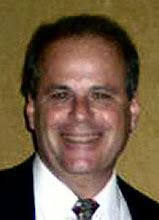For the last twenty-four years, Todd Ivler has been the General Manager of Mount Judah Cemetery, located in Ridgewood, Queens, New York. He is a man who is very dedicated to his work. He is affable and extremely helpful to those who need his assistance. In essence, he is the model of what a cemetery manager should be.
Todd sat down for an interview with the Museum of Family History last summer and most graciously answered every question put to him . You can read the entire interview online within the Museum's "Q & A: Interview with a Cemetery Manager."
It is important to note from the outset that every cemetery is different. Each has its own policies (although their policies may be similar or the same), whether it has to do with how they care for their grounds, how they might number a grave or row or grave in a particular plot, or even how their searchable database (if they have one) may be structured, etc.
...............................................................................................
The Museum asked Todd about the procedure that takes place once someone who has a plot at Mt. Judah passes on, from the moment the family or funeral director calls his cemetery office:
"... A lot of times we get a call directly from the family, saying that my mother died or my father died, for instance. We’ll take some information from them, but ideally we only really take funeral information from a funeral home. Once we get the phone call, we take down some information; there are a certain number of questions that we ask. Once we have the answers to those questions, if they give us the name of the society or a family plot where the person's going to be buried, we’ll go pull out that card or that map...
Basically the only information we need at that point is name of the deceased, and if they know where—or the funeral home knows where—they’re going to be buried. If they don’t know where the deceased is going to be buried, then we go from there. Then we start asking more questions, e.g. family name, next-of-kin name. We might be able to trace it that way. Did the person buy the grave directly from the cemetery? There are a lot of ways of going about finding out where the problem is.
Well, if the information is good information, it makes things very easy for us. A lot of times funeral homes are already pre-prepared, if the family had gone in to see them first, which is something that I highly recommend people doing. At that point, we get out our maps, I send the foreman or the superintendent out to the grounds, he double-checks to make sure the grave is empty, to make sure it is the grave it’s supposed to be. If it’s next to a spouse under a double headstone, the grave is a little easier to find, easier then if it was a single grave in the middle of literally nowhere on a vacant line. When we find the grave, at that point we determine that it’s going to be a good burial. We call the funeral home back and make what we call “final arrangements." We get the next-of-kin’s name and set up the day and the date of the funeral."
................................................................................................
To read more about this and learn more about the inner workings of a typical Jewish cemetery, please read the interview in full at www.museumoffamilyhistory.com/qna-cem-mgr.htm.
Friday, August 21, 2009
Q & A: Interview with a Cemetery Manager
Subscribe to:
Post Comments (Atom)




No comments:
Post a Comment